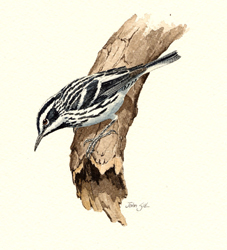Breeding Bird Atlases (BBA)
Find a Bird - BBA1
Breeding Bird Atlas 1 Species Accounts
Black-and-white Warbler
Mniotilta varia
Egg Dates
May 18 to June 14
Number of Broods
one

The Black-and-white Warbler is one of the most common warblers in broad-leaved woodlands throughout the state, occurring in both mature and young deciduous forest. It is less common in primarily coniferous woods. The species was confirmed as a breeder throughout Massachusetts, including Cape Cod and the Islands, wherever there was suitable habitat. It is a notably distinctive warbler, with its zebra-striped plumage and habit of creeping about nuthatchlike on tree trunks as it searches for insects.
The Black-and-white Warbler is among the first of the wood-warblers to return in the spring, arriving near the end of April with the Yellow-rumped Warbler and Palm Warbler. Its distinctive song is a familiar element of the dawn chorus of early spring warbler waves. Migration continues into early May, with only stragglers passing through by the end of the month. During migration, the birds may be seen anywhere that there are sufficient trees for foraging.
The song, which is among the easiest warbler songs to learn, is a high-pitched squeeky, squeeky, squeeky or wee-see, wee-see, wee-see. A longer and more complex version is given during the breeding season. Two common call notes of both sexes are a sharp chink and a weak tsip. The birds also string a series of calls together to produce a rattling chatter, which is commonly used as a begging call by the young.
Males generally arrive first and claim a territory, which they defend vigorously. During courtship, they chase prospective mates and perch near them with fluttering wings. Females are the principal nest builders, constructing a small, well-concealed structure of dry leaves and grasses on the ground at the base of a tree trunk or fallen log. Nearly all Massachusetts nests reported were in such locations, but there are a few rare state records for nests located several feet up on dead stumps or tree trunks (ACB). A recent nest in Charlton was built at the base of the trunk of one of a group of young White Pines near a field grown up to saplings (Meservey). Females in southern Worcester County were observed gathering nesting material from May 27 to June 9 (Meservey).
The female incubates the eggs, which are whitish with small brown splotches, for 10 to 12 days. Clutch sizes for 4 Massachusetts nests were four eggs (1 nest), five eggs (3 nests) (DKW). Like other ground-nesting birds, the female Black-and-white Warbler will engage in a broken-wing display if a potential predator approaches the nest. Males assist in feeding the young and may also attempt to aid in luring intruders away. The young fledge in 8 to 12 days. In Massachusetts, adults were observed feeding nestlings from June 6 to June 17 and fledged young from June 21 to August 14 (Meservey). Only a single brood occurs each season. This species is among those heavily parasitized by the Brown-headed Cowbird.
By late summer, when breeding and molting are completed, the Black-and-white Warbler joins mixed foraging flocks of chickadees, titmice, nuthatches, and other warblers. The southward migration begins in late August and continues throughout September, with numbers greatly diminished by October. The vast winter range extends from the Gulf states south through Mexico, Central America, and some of the Caribbean Islands to South America.
Map Legend and Data Summary
Atlas 1 data collected from 1975-1979


Note: uncommon to fairly common and widespread throughout the state in mixed and deciduous woodlands
John C. Kricher



